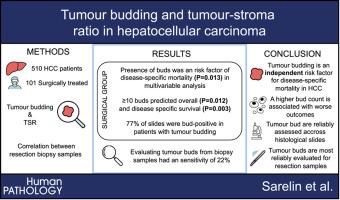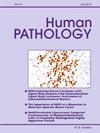肝细胞癌的肿瘤出芽及间质比。
IF 2.6
2区 医学
Q2 PATHOLOGY
引用次数: 0
摘要
目的:先前的研究表明肝癌(HCC)中肿瘤出芽与预后不良之间存在联系,而肿瘤间质比(TSR)的预后价值尚不清楚。本研究评估肿瘤芽和TSR在HCC中的预后价值。方法:来自两个芬兰中心的510例HCC病例。该队列分为手术组(n=101)和非手术治疗组(n=405)。生存分析基于芽阳性(≥1芽)和芽阴性(0芽)的样本,并具有低TSR(结果:多变量分析中,肿瘤芽阳性与5年总死亡率增加无关(HR 2.00, 95% CI, 0.98-4.07),但是疾病特异性死亡率的独立危险因素(HR 2.53, 95% CI, 1.06-6.02, P=0.036)。TSR与5年总生存率或疾病特异性生存率无关。与切除样本相比,活检样本在识别肿瘤出芽病例方面的敏感性为22%,特异性为100%。结论:肿瘤出芽是手术治疗HCC患者疾病特异性死亡率的独立危险因素。我们的结果表明,肿瘤芽是最可靠的评估使用切除样本。本文章由计算机程序翻译,如有差异,请以英文原文为准。

Tumour budding and tumour-stroma ratio in hepatocellular carcinoma
Objectives
Tumour budding has been linked with poor prognosis in hepatocellular carcinoma (HCC), while the prognostic value of tumour-stroma ratio (TSR) remains unclear. We assessed the prognostic value of tumour buds and TSR in HCC.
Methods
506 HCC cases were included. Survival analysis was performed separately for surgical (n=101) and non-surgical patients (n=405) based on the presence of tumour buds, and having low TSR (<50 %) and high TSR (≥50 %). Bud-positive patients were further categorised according to tumour bud quantity (1–4 buds, 5–9 buds, and ≥10 buds), and the presence of tumour buds accross multiple sections of the same tumour was evaluated. We also analysed the correlation of tumour buds and TSR between biopsy and resection samples.
Results
Positive tumour budding was not associated with increased 5-year overall mortality in multivariable analysis (HR 2.00, 95 % CI, 0.98–4.07), but was an independent risk factor for disease-specific mortality (HR 2.53, 95 % CI, 1.06–6.02, P = 0.036). The presence of ≥10 buds was an independent risk factor of overall- and disease-specific mortality in multivariable analysis. Tumour buds were found in 77% of slides in bud-positive patients. TSR was not linked with 5-year overall survival or disease-specific survival. Biopsy samples demonstrated a low sensitivity of 22 % in identifying tumour budding compared to the resection samples.
Conclusion
Tumour budding was an independent risk factor for disease-specific mortality in surgically treated HCC patients, with higher bud counts indicating poorer outcomes. Tumour buds were consistently found across slides. Furthermore, our results suggest that tumour buds are most reliably evaluated using resection samples.
求助全文
通过发布文献求助,成功后即可免费获取论文全文。
去求助
来源期刊

Human pathology
医学-病理学
CiteScore
5.30
自引率
6.10%
发文量
206
审稿时长
21 days
期刊介绍:
Human Pathology is designed to bring information of clinicopathologic significance to human disease to the laboratory and clinical physician. It presents information drawn from morphologic and clinical laboratory studies with direct relevance to the understanding of human diseases. Papers published concern morphologic and clinicopathologic observations, reviews of diseases, analyses of problems in pathology, significant collections of case material and advances in concepts or techniques of value in the analysis and diagnosis of disease. Theoretical and experimental pathology and molecular biology pertinent to human disease are included. This critical journal is well illustrated with exceptional reproductions of photomicrographs and microscopic anatomy.
 求助内容:
求助内容: 应助结果提醒方式:
应助结果提醒方式:


